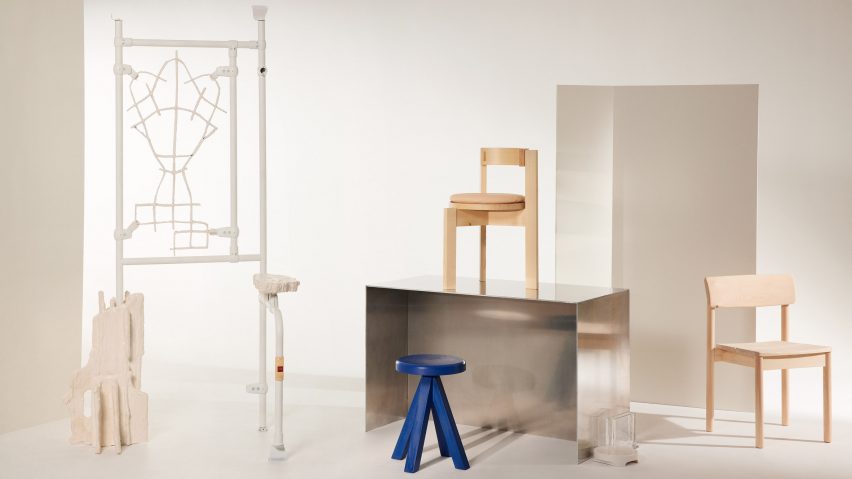A bench sculpted with a chainsaw and a chair made from flooring offcuts were among exhibits at this year's Norwegian Presence exhibition at Milan design week, which explored inventive ways of using raw materials.
Titled Matter, the eighth edition of the annual Norwegian Presence showcase set out to present Norwegian designers and brands who are finding innovative but responsible ways of producing furniture and products.
Staged at Galleria Milano in Brera, the exhibition spotlighted 10 designers who are using simple materials like natural wood, stone and aluminium, and finding new ways of elevating them.
The curators, Oslo studio Kråkvik & D'Orazio, hoped to highlight how Norway's natural resources have shaped the country's design and manufacturing identity.
"This year, we wanted to study Norway's natural resources and the possibility of a more environmentally friendly future," said Jannicke Kråkvik, co-founder of Kråkvik & D'Orazio.
"Profound knowledge of our natural resources paves the way for a forward-thinking industry," she said.
Among the most eye-catching pieces on show was the Vride Bench, created from ash wood by designer Anna Maria Øfstedal Eng.
Øfstedal Eng used a chainsaw to give her design a more organic feel, inspired by tree branches and roots.
Pettersen & Hein's Offcut Chair 01 was produced using waste material from flooring company Dinesen.
The Douglas fir offcuts are used in the sizes they come in, to minimise waste, and assembled into a set with a sandwich construction.
Another designer using offcuts was Henrik Ødegaard, who created a series of 14 lacquered pine hooks using scrap material from furniture production.
Brave New Lines showcased a bench made by simply folding a standard sheet of corrugated aluminium, while Poppy Lawman presented a maple table with a flame-treated finish.
The most colourful designs on display came from industrial designer Hallgeir Homstvedt and ceramicist Julia K Persson.
Homstvedt unveiled Shift, an aniline-dyed wooden stool that conceals an ergonomic mechanism, while Persson showed sculptural representations of steel I-beams.
Other designs included a cork-bodied lamp by Edvin Klasson, a room divider made from old city bus handrails by Nebil Zaman, and a series of stone vases and trays by Tron Meyer.
The exhibition also featured the work of eight Norwegian brands: textile brand Gudbrandsdalens Uldvarefabrik, paint company Jotun, aluminium manufacturer Hydro, stone producer Lundhs, homeware brand Nedre Foss and furniture companies Vestre, Fjordfiesta and Minus.
Matter becomes the first physical Norwegian Presence exhibition in three years, after the pandemic led to the previous two editions taking place digitally.
Previous exhibitions have explored topics including the circular economy, the power of collaboration and design heritage.
Exhibition director Cecilie Molvær Jørgensen hoped that visitors to this year's show left with a sense of optimism for the future of Norwegian design.
"A brand new generation – and with it, a new set of ideas – has entered the Norwegian design scene in the past few years," she said.
"They are more experimental, more conscientious, more playful in their expression – and the most daring Norwegian manufacturers are following suit. Together, they are looking to the future, determined to be the ones that shape it."
Matter by Norwegian Presence was part of Milan design week 2022, which took place from 6 to 12 June 2022. See our Milan design week 2022 guide on Dezeen Events Guide for information about other exhibitions, installations and talks from the week.

